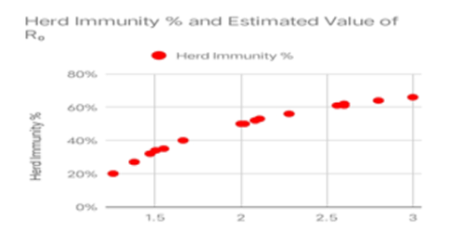


Indian Journal of Science and Technology
Year: 2021, Volume: 14, Issue: 35, Pages: 2773-2777
Original Article
Mohit Soni1*, Rajesh Kumar Sharma1, Shivram Sharma2
1Department of Mathematics, Government Holkar Science College, Indore, M P, India
2Government P. G. College, Guna, M P, India
*Corresponding Author
Email: [email protected]
Objectives: To estimate the basic reproduction number and herd immunity in India relative to the viral disease COVID-19. Methods: In this study, we analyzed literature from March-2020 to January-2021, which were related to the basic reproduction number and herd immunity of COVID-19 in India. Also, we found the mean value of the basic reproduction number and herd immunity as a result. Findings: According to our study, the basic reproduction number and the percentage of the herd immunity ranged from 1.2561 to 3 and from 20% to 66%, respectively. The mean value of the basic reproduction number and the percentage of the herd immunity is 2.0546 and 51% respectively. Novelty: To the best of our knowledge, no such studies have been conducted in India.
Keywords: Basic reproduction number; Herd immunity; COVID19; Vaccination; Regression; etc
© 2021 Soni et al. This is an open access article distributed under the terms of the Creative Commons Attribution License, which permits unrestricted use, distribution, and reproduction in any medium, provided the original author and source are credited. Published By Indian Society for Education and Environment (iSee)
Subscribe now for latest articles and news.